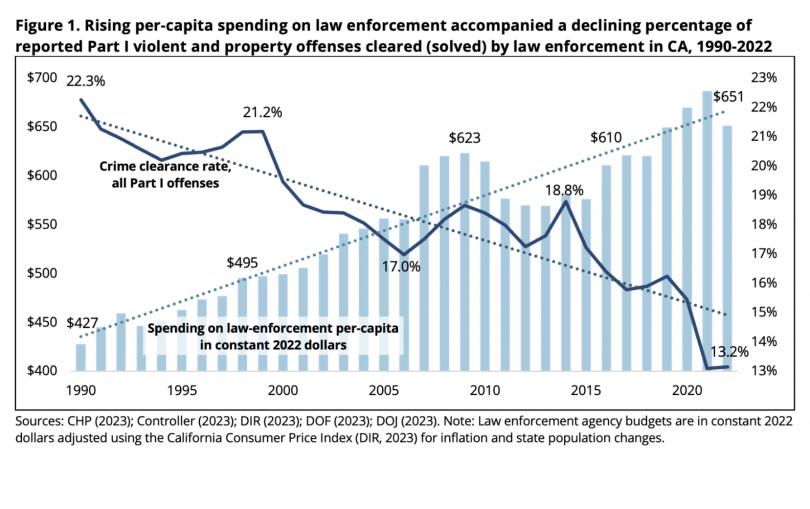Over the past three decades, clearance rates for serious crimes have dropped by 41 percent in California, according to a new report by Dr. Mike Males, Senior Research Fellow at the Center on Juvenile and Criminal Justice (CJCJ).
Crime clearance rates are the closest measures we have to showing how many crimes are solved. A crime is considered “cleared” (or solved) if law enforcement arrests someone for that crime and refers them to the district attorney’s office for prosecution.
Clearance rates for offenses categorized federally as Part I crimes — murder, rape, robbery, aggravated assault, burglary, larceny-theft, and grand theft auto — dropped from 22.3% in 1990, to 13.2% in 2022, the CJCJ report shows.
While robbery clearance rates have increased by 16%, and murder clearance rates have improved by 1%, numbers have dropped precipitously for rape (-47%), larceny-theft (-66%), grand theft auto (-35%), burglary (-22%), and aggravated assault (-21%).
Over these same decades, overall crime rates have been on a downward trajectory, and law enforcement agencies are making more money than ever before.
No “defunding the police” here
Between 1990 and 2022, per-capita spending on police — in inflation-adjusted dollars — rose approximately 52% from $427 in 1990, to $651 in 2022, according to Males’s analysis. As a whole, Californians spend $25.5 billion on law enforcement each year.
Males is careful to point out that clearance rates for property crimes were dropping “long before the justice reform era.”
“Anti-reform lobbies, police officials and unions, and many press reports wrongly criticize criminal justice reforms and progressive district attorneys for failing to hold people accountable for crime,” Males writes.
Critics have blamed justice reforms like Proposition 47 — approved by voters in 2014 to reduce six low-level drug and property-related offenses to misdemeanors — for a drop in prison admissions for property crimes.
“While prison admissions for property offenses did fall by 24% from 2014 (just before Proposition 47 took effect) to 2022, much of the responsibility for this decline lies with police departments whose felony property crime clearance rates fell even faster (by 50%) during the period,” says Males. “In fact, the likelihood of prison admissions per cleared property offense rose by 13% from 2014 to 2019, the latest year before COVID-19 restrictions temporarily reduced new prison admissions.”
Males says this data suggests that, instead of inflating police budgets, more funding should go to community programs that meet people’s underlying needs, thus getting to “the root cause of crime and violence” for far less money.
“True reform requires targeted strategies like these that address people’s underlying needs through housing support, education, mental health services, drug treatment, and more,” writes Males. “Heavily investing in police is not working. Instead, jurisdictions should explore alternatives to policing for those problems other community organizations and agencies are better positioned to address.”

